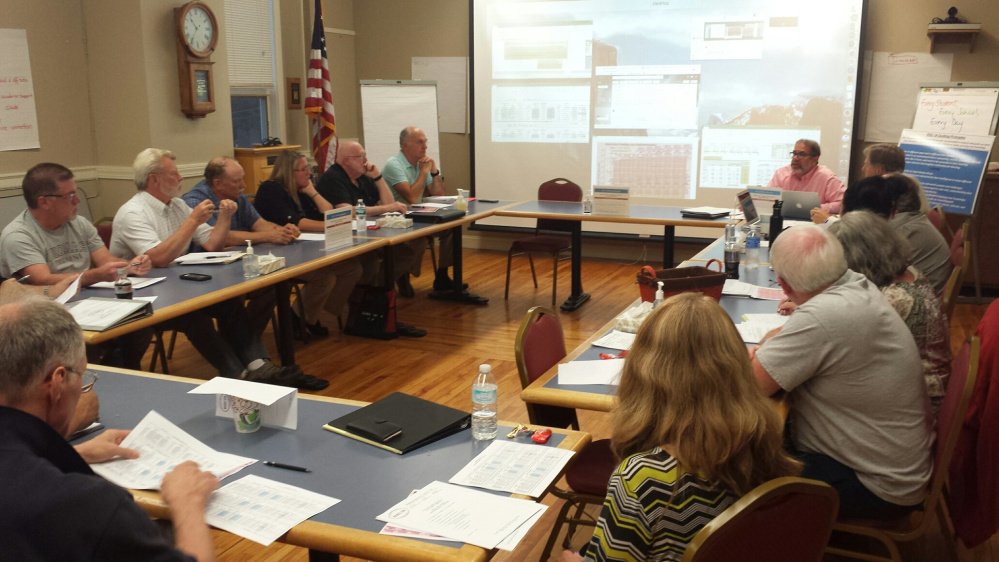A cost-sharing committee formed every five years to determine how much money the five towns of Regional School Unit 18 have to raise for the district left its second meeting at odds over how to adjust the current formula and whether to add new components.
RSU 18 creates an ad hoc committee every five years with two voting members each from Oakland, Belgrade, Rome, Sidney and China. The committee’s meetings are open to the public and held in the district’s central office on Heath Street in Oakland. Most committees decide on a formula within three to five meetings, Superintendent Gary Smith said.
One person from the public attended the group’s second meeting Thursday night.
Currently, the formula weighs property valuations at 75 percent and student count at 25 percent, on a three-year average of both.
The committee is tasked with finding a solution that is fair and equitable to all towns, but it also must keep in mind that any changes must be voted on in a referendum.
If the committee adjusts how the student count and property valuation are weighed, the formula must pass by a majority of all the towns put together. However, if the committee decides to add another factor into the formula, it would have to pass by a majority individually in each town.
Committee member Dennis Keschl, of Belgrade, said only about four school districts in the state have formulas that have factors beyond student count and valuation.
Smith presented multiple spreadsheets that showed what would happen in different scenarios. In one, he compared the cost per student, or tuition rate, in each town. Currently, the tuition range between towns is $940.
This doesn’t include Rome, which pays a nearly half the property tax rate as the other towns but receives no state funding. The state created an alternative for towns such as Rome with low student populations and high valuations. Rome has 123 students in the district but would pay about $2.45 million as its required local share if its tax rate was $8.30 per $1,000 of property valuation. Instead it has a rate of $4.37 and pays $1.29 million.
Smith changed the formula to 100 percent student count and 0 percent valuations, which achieved the lowest range in tuition rate at $31. The cost per student in every town was about $11,800. However, Smith then put different numbers into a spreadsheet that broke down how the changes would affect each town individually. The 100-to-0 ratio would save Rome and Belgrade hundreds of thousands of dollars but cost the other three towns in the district almost as much.
Committee member Mary-Anne LaMarre, of Oakland, said there were multiple reasons why the group should look at weighing valuation more over student count. An 100-to-0 ratio swinging toward valuation would have a lesser effect on each town, benefit three of the five towns involved and have a greater chance of getting passed.
With that formula, the spreadsheet shows that China, Oakland and Sidney would pay $43,000 to $91,000 less, while Belgrade and Rome each would pay a little less than $100,000 more.
Committee member Andy Cook, of Rome, proposed the opposite ratio, weighing student count at 100 percent and valuation at 0 percent.
“The benefit is that the members of your town can see tangibly what they’re contributing to the premium for the student’s education,” Cook said. He said the district could better market its additional costs if it were able to say they definitively went to the student population, and the per-student tuition rate across towns was fairly even.
Laura Tracy, of Oakland, said she agreed with Cook that the committee would be able to make that point if it weighed student count more heavily, but she still doubted it would pass.
“There’s too much challenge in this district in passing budgets,” she said. “We have to make sure we feel comfortable that this will pass.”
Tracy and other members wanted to look back at why the committee before this decided to weigh valuations more than student count.
“We’re not plowing new ground,” said Tim Russell, of Sidney, who was on the previous committee. “We did this.”
About five people on the current cost sharing committee had been on previous ones.
Tracy, who also served on the committee previously, said she remembers making the decision based on what would have the least overall effect, which she said is supported by Smith’s spreadsheet demonstrations.
Keschl, though, said the problem is that the group isn’t looking at factors such as median household income and median home values. Belgrade, he said, has the lowest median household income, second only to Oakland; but Oakland has a lower median home value than Belgrade.
“I think it has to be part of the discussion,” he said. While others agreed, many members doubt that adding factors and raising the majority requirement will help the committee pass the formula at the polls.
The meeting ended without an clear end to the discussion, which will be continued at the next meeting at 6 p.m. Thursday, Nov. 3.
Madeline St. Amour — 861-9239
mstamour@centralmaine.com
Twitter: @madelinestamour
Send questions/comments to the editors.




Success. Please wait for the page to reload. If the page does not reload within 5 seconds, please refresh the page.
Enter your email and password to access comments.
Hi, to comment on stories you must . This profile is in addition to your subscription and website login.
Already have a commenting profile? .
Invalid username/password.
Please check your email to confirm and complete your registration.
Only subscribers are eligible to post comments. Please subscribe or login first for digital access. Here’s why.
Use the form below to reset your password. When you've submitted your account email, we will send an email with a reset code.